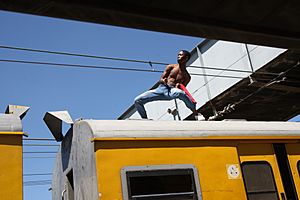Danger facts for kids

Danger is the chance that something bad or harmful could happen. It's also called risk or peril. If a situation has a high chance of something bad happening, we call it dangerous, risky, or perilous.
People sometimes do things that might hurt them, even if they know it's risky. For example, if you cross the road without looking carefully, there's a chance you could get hit by a car. That's a dangerous situation.
Anything that could cause injury or harm to your health can be described as dangerous. For instance, some habits can be dangerous to your health over time. Also, being around certain wild animals can be dangerous because they might attack humans.
Contents
Understanding How We Measure Danger
We can often measure how dangerous something is by using numbers. This helps us understand risks better.
What is Probability?
Probability is a way to measure how likely something is to happen. It uses math to figure out the chance of a specific event occurring. For example, if we say the probability of rain is 50%, it means there's an equal chance it will rain or not.
In health studies, probability helps us understand risks in a group of people. For instance, if we say the risk of a certain health issue in babies is 1 out of 1,000, it means that for every 1,000 babies born, about 1 might face that issue.
Risk and How Often Things Happen
When we talk about health, we sometimes use terms like prevalence and risk.
- Prevalence tells us how many people in a group currently have a certain condition or disease. It's like taking a snapshot of how many people are affected right now.
- Risk (or incidence) tells us about new cases of a disease. It's the number of new people who get a disease, divided by the number of people who could have gotten it. For example, during a flu outbreak, the risk would be the number of people who get the flu, divided by everyone who was around the flu virus.
What is a Risk Assessment?
A risk assessment is like a checklist of things that could go wrong in a situation. It also lists what you should do to prevent bad things from happening.
For example, when teachers take children on a school trip, they often fill out a risk assessment form. This form lists possible dangers, like accidents or children getting lost. It also explains what steps they will take to keep everyone safe, such as having enough adult supervisors or a plan for what to do if someone gets separated from the group. This helps make sure everyone stays safe and prepared.
Related pages
See also
 In Spanish: Danger para niños
In Spanish: Danger para niños


